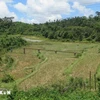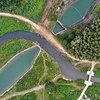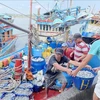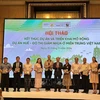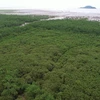Regional cooperation is needed to cope with climate change in Southeast Asia, speakers said at a symposium held in the Mekong Delta city of Can Tho on June 4.
Eighty local and foreign experts in global-warming adaptation are in Can Tho for a regional symposium that involves government partners, non-government organisations (NGOs), donor agencies and corporate partners.
Experts at the three-day event are discussing innovative climate-change mitigation models that have been successfully implemented in Southeast Asia .
The goals of the symposium include creating a dialogue between partners in the ASEAN community and designing effective community-based climate-change adaptation models.
Two to three possible adaptation measures will be taken back to each partner office to share with the local community in Can Tho.
The community partners will then help design the preferred adaptation models.
Based upon the local context in Laos and Vietnam , the symposium will place a specific focus on climate-change mitigation in agriculture and natural-resource management at the community level.
A low-lying, densely populated area, the Mekong Delta is the heart of rice production in Vietnam and is one of the world's most vulnerable regions to climate change.
"Our side of the project will be based in Can Tho, where 84 percent of its area is used for agriculture, with more than 90 percent of it for rice production," said Nguyen Minh The, Deputy Director of Can Tho's Department of Natural Resources and Environment.
"The average alleviation of the province lies between 0.6 and 0.8 metres above sea level and it is particularly susceptible to river and seawater intrusion," he added.
Experts predicted that a possible 30cm rise in sea levels could destroy the city's rice crops, he added.
Other climate-change related issues are floods, landslides, upstream climate and land-use changes exacerbate the threat, resulting in saline intrusion and water shortages.
If the flood tides continue to rise at the current pace, by 2030 they could reach a height of 2.5-3 metres. At that time, the entire city could be under water.
The unpredictability of weather is already making farming activities difficult, and, in many cases, has reduced production.
According to The, efforts are needed to implement climate-change adaptation and mitigation initiatives, especially at the community-based level, so that poor farmer households and the rest of the community can become more resilient and adaptive.
Christy Owen, Deputy Chief of the Mekong Adaptation and Resilience to Climate Change project, said that food security, health and the livelihoods of many of the Lower Mekong's 60 million residents were dependent on the Mekong River 's natural system and services, particularly for crop irrigation and fisheries.
Also speaking at the symposium, Nguyen Huong Thuy Phan, programme coordinator for the Climate-Change Adaptation Initiatives of the Mekong River Commission Secretariat, attributed the region's challenges to high uncertainty about future climate projections, particularly in relation to extreme events.
Ian Wood, team leader for climate-change adaptation for the non-profit organisation Winrock International, based in the US , said that climate change was indeed a reality, and that temperatures were increasing, sea levels rising, and rainfall becoming more variable.
As a result, Southeast Asia would continue to suffer from floods, droughts, high temperatures and the impact of salinity, he added.
The symposium in Can Tho is one component of the Southeast Asia : Regional Environmental Adaptation to Climate Change Training and Implementation Project that also kicked off on June 4.
The goal of the project is to develop specialised training in innovative climate-change adaptation techniques that further sustainable agriculture and natural-resource management.
The project also seeks to equip rural communities with the tools to plan for the future in the face of escalating climate-change effects.
Under the project, two eight-month pilot projects in Vietnam and Laos will be designed and implemented at the community level, including an effective M&E framework and an experience-sharing trip to learn from other communities.
Southeast Asia is increasingly being affected by extreme climate change, such as floods, droughts and tropical cyclones.
People who are most affected by climate change are the rural poor living in areas with limited adaptive capacity.
According to the most recent Intergovernmental Panel on Climate Change Assessment Report, Southeast Asia is expected to be greatly affected by climate change, especially the agriculture industry.-VNA
Eighty local and foreign experts in global-warming adaptation are in Can Tho for a regional symposium that involves government partners, non-government organisations (NGOs), donor agencies and corporate partners.
Experts at the three-day event are discussing innovative climate-change mitigation models that have been successfully implemented in Southeast Asia .
The goals of the symposium include creating a dialogue between partners in the ASEAN community and designing effective community-based climate-change adaptation models.
Two to three possible adaptation measures will be taken back to each partner office to share with the local community in Can Tho.
The community partners will then help design the preferred adaptation models.
Based upon the local context in Laos and Vietnam , the symposium will place a specific focus on climate-change mitigation in agriculture and natural-resource management at the community level.
A low-lying, densely populated area, the Mekong Delta is the heart of rice production in Vietnam and is one of the world's most vulnerable regions to climate change.
"Our side of the project will be based in Can Tho, where 84 percent of its area is used for agriculture, with more than 90 percent of it for rice production," said Nguyen Minh The, Deputy Director of Can Tho's Department of Natural Resources and Environment.
"The average alleviation of the province lies between 0.6 and 0.8 metres above sea level and it is particularly susceptible to river and seawater intrusion," he added.
Experts predicted that a possible 30cm rise in sea levels could destroy the city's rice crops, he added.
Other climate-change related issues are floods, landslides, upstream climate and land-use changes exacerbate the threat, resulting in saline intrusion and water shortages.
If the flood tides continue to rise at the current pace, by 2030 they could reach a height of 2.5-3 metres. At that time, the entire city could be under water.
The unpredictability of weather is already making farming activities difficult, and, in many cases, has reduced production.
According to The, efforts are needed to implement climate-change adaptation and mitigation initiatives, especially at the community-based level, so that poor farmer households and the rest of the community can become more resilient and adaptive.
Christy Owen, Deputy Chief of the Mekong Adaptation and Resilience to Climate Change project, said that food security, health and the livelihoods of many of the Lower Mekong's 60 million residents were dependent on the Mekong River 's natural system and services, particularly for crop irrigation and fisheries.
Also speaking at the symposium, Nguyen Huong Thuy Phan, programme coordinator for the Climate-Change Adaptation Initiatives of the Mekong River Commission Secretariat, attributed the region's challenges to high uncertainty about future climate projections, particularly in relation to extreme events.
Ian Wood, team leader for climate-change adaptation for the non-profit organisation Winrock International, based in the US , said that climate change was indeed a reality, and that temperatures were increasing, sea levels rising, and rainfall becoming more variable.
As a result, Southeast Asia would continue to suffer from floods, droughts, high temperatures and the impact of salinity, he added.
The symposium in Can Tho is one component of the Southeast Asia : Regional Environmental Adaptation to Climate Change Training and Implementation Project that also kicked off on June 4.
The goal of the project is to develop specialised training in innovative climate-change adaptation techniques that further sustainable agriculture and natural-resource management.
The project also seeks to equip rural communities with the tools to plan for the future in the face of escalating climate-change effects.
Under the project, two eight-month pilot projects in Vietnam and Laos will be designed and implemented at the community level, including an effective M&E framework and an experience-sharing trip to learn from other communities.
Southeast Asia is increasingly being affected by extreme climate change, such as floods, droughts and tropical cyclones.
People who are most affected by climate change are the rural poor living in areas with limited adaptive capacity.
According to the most recent Intergovernmental Panel on Climate Change Assessment Report, Southeast Asia is expected to be greatly affected by climate change, especially the agriculture industry.-VNA





